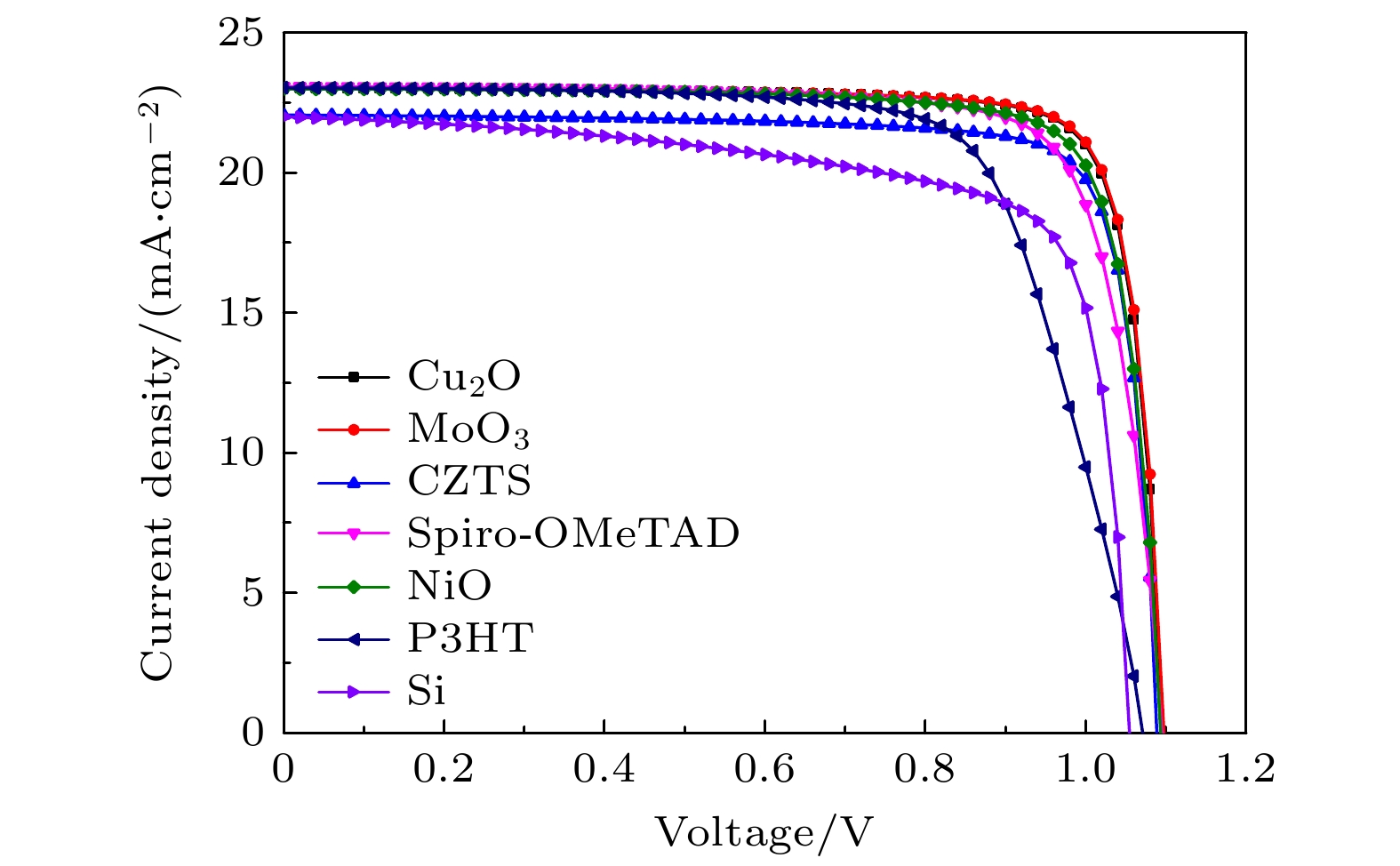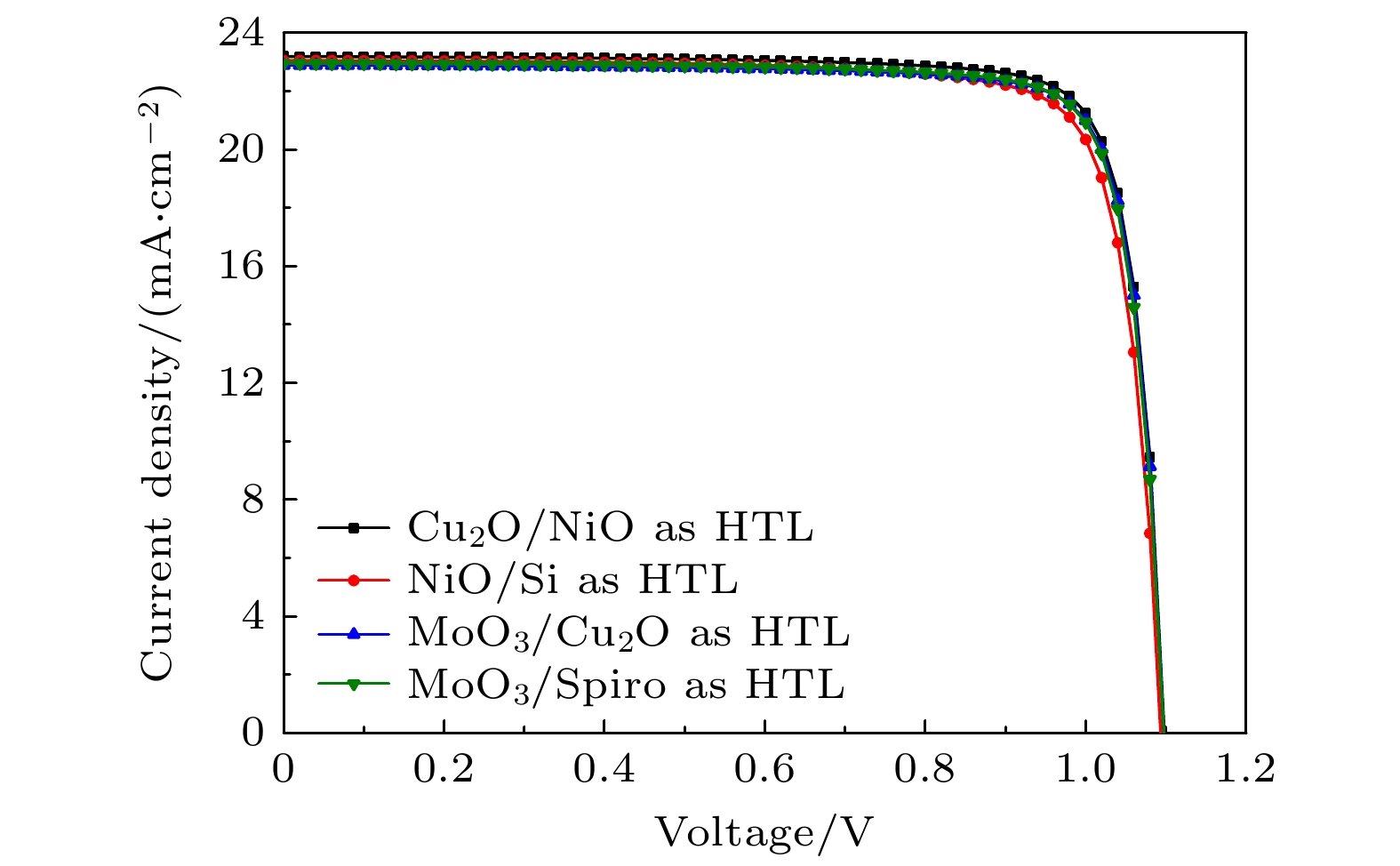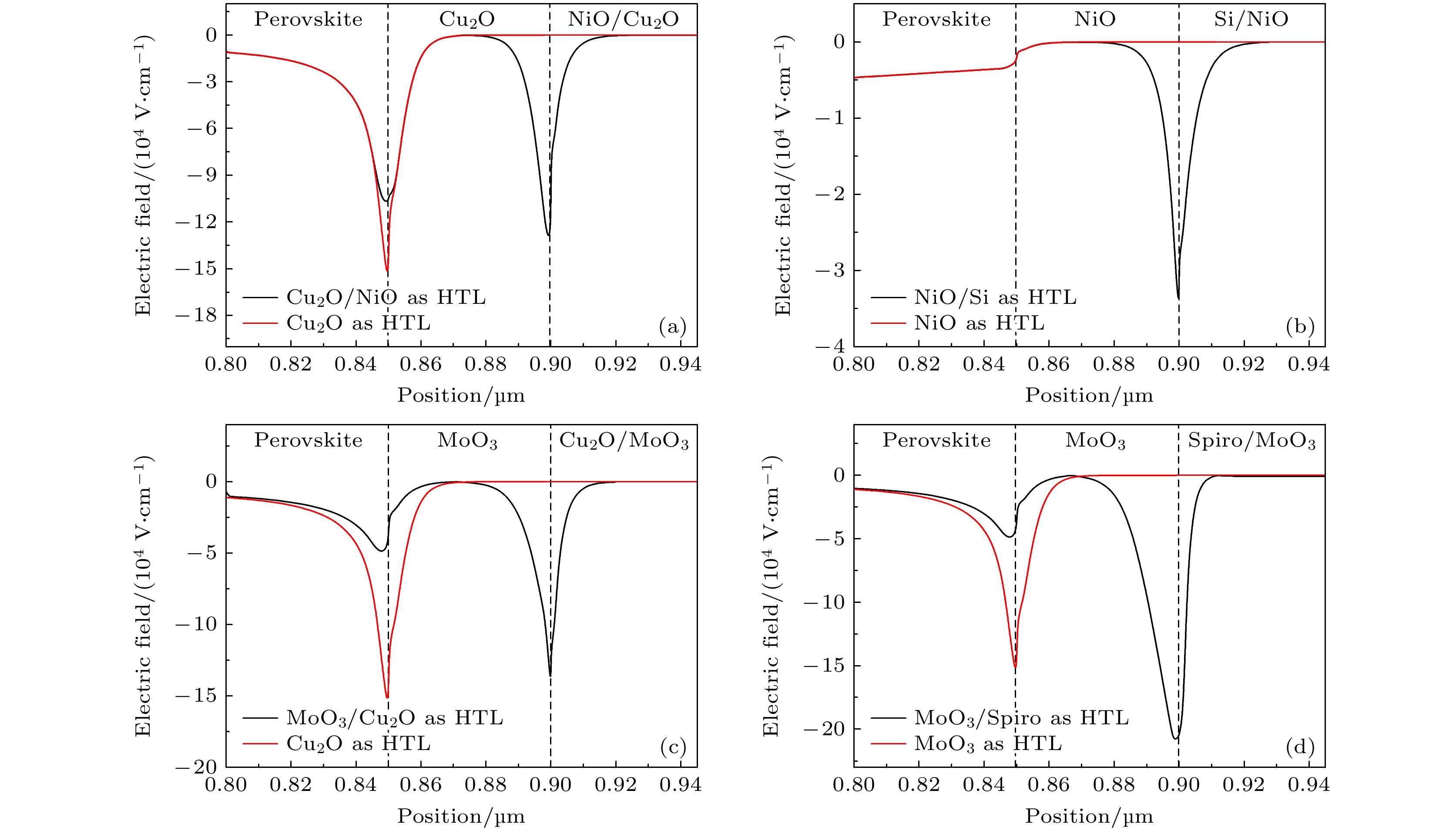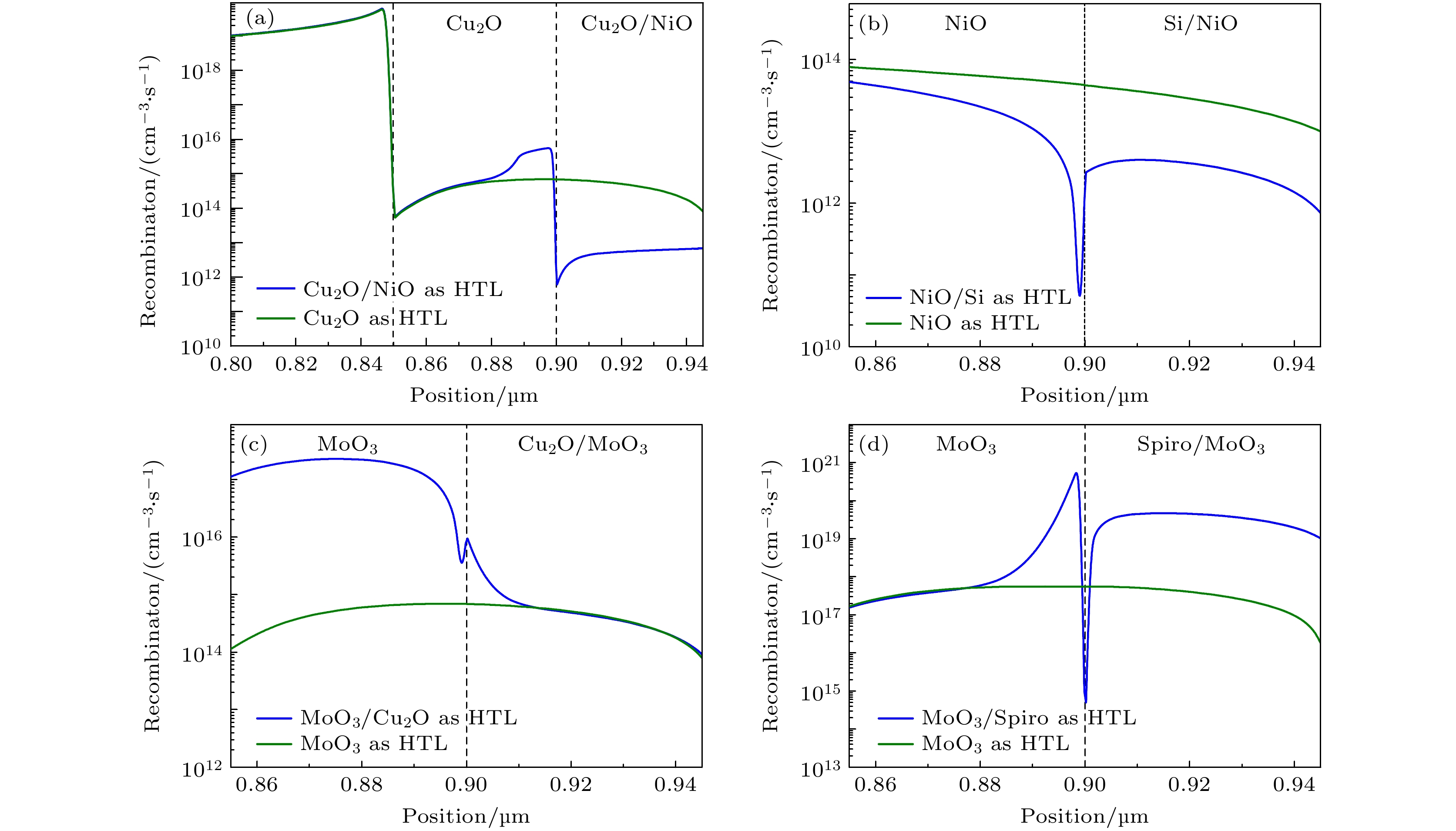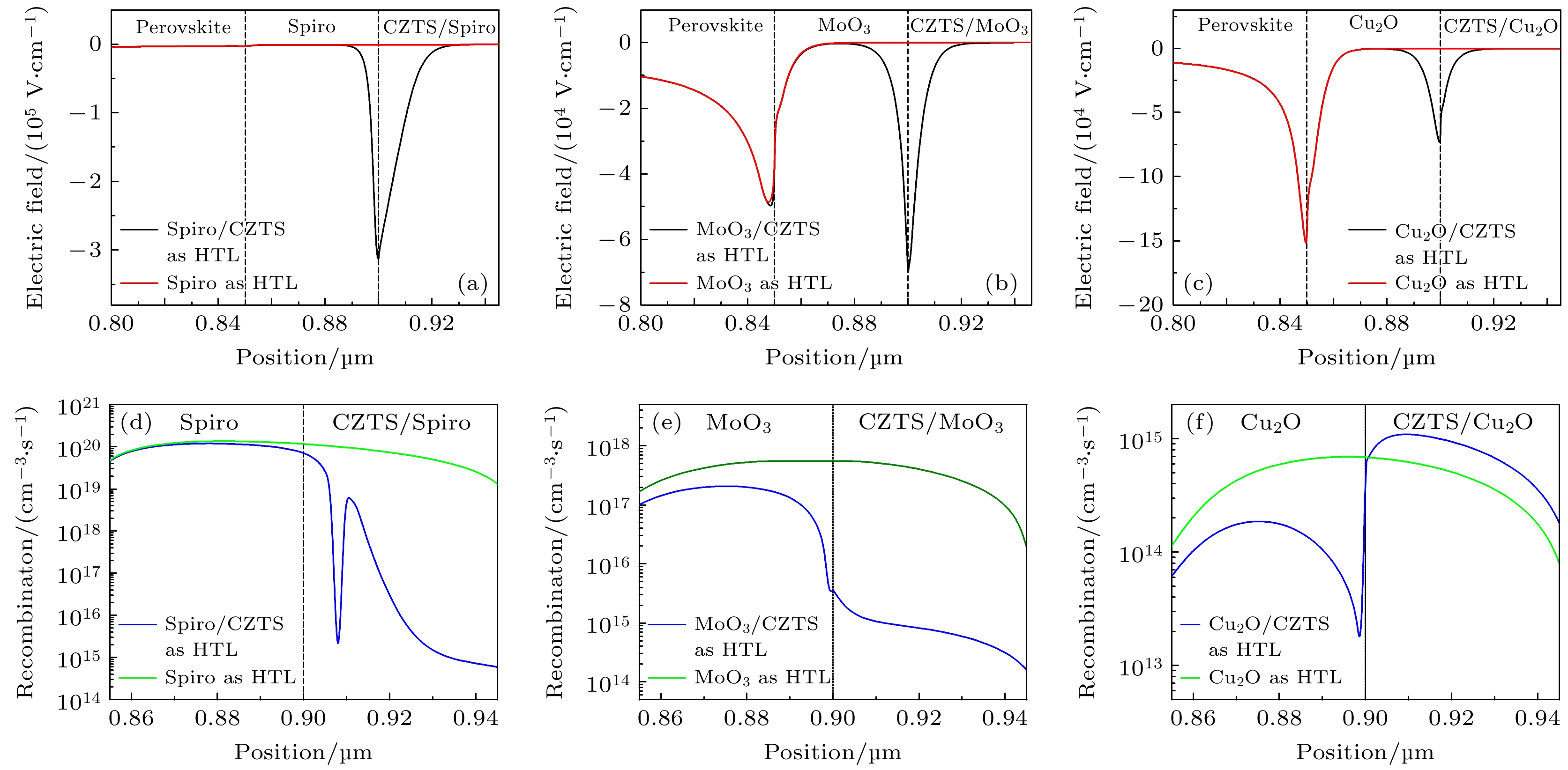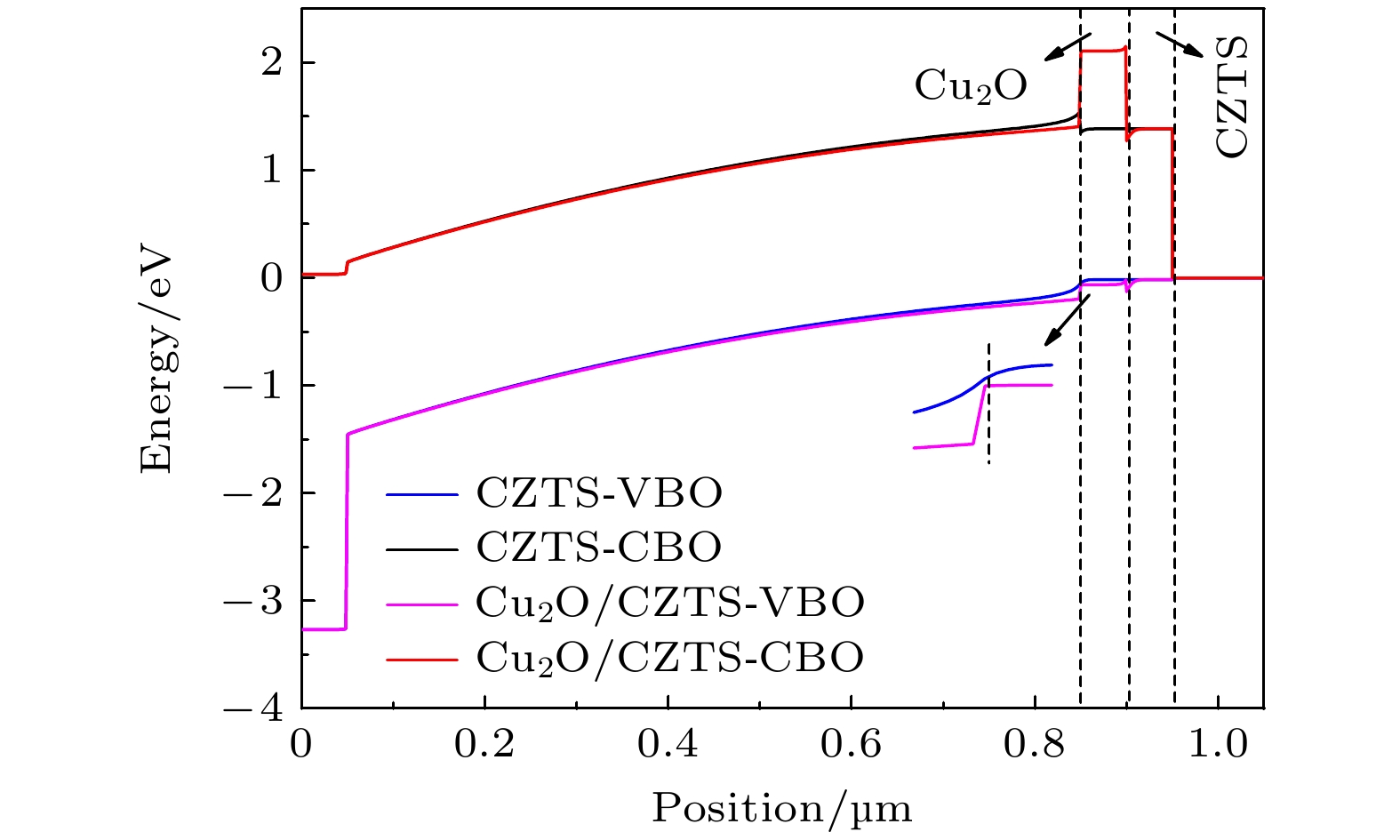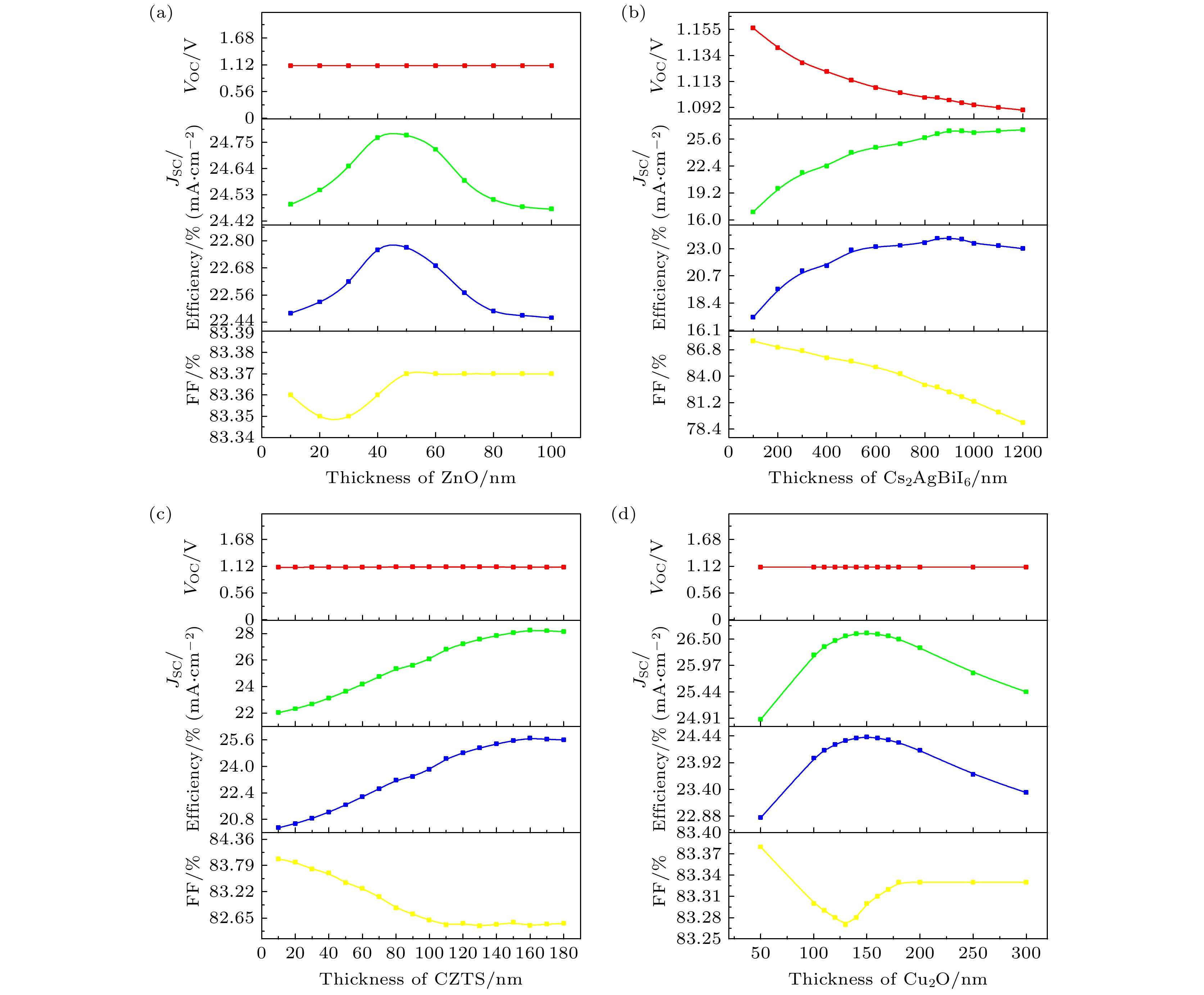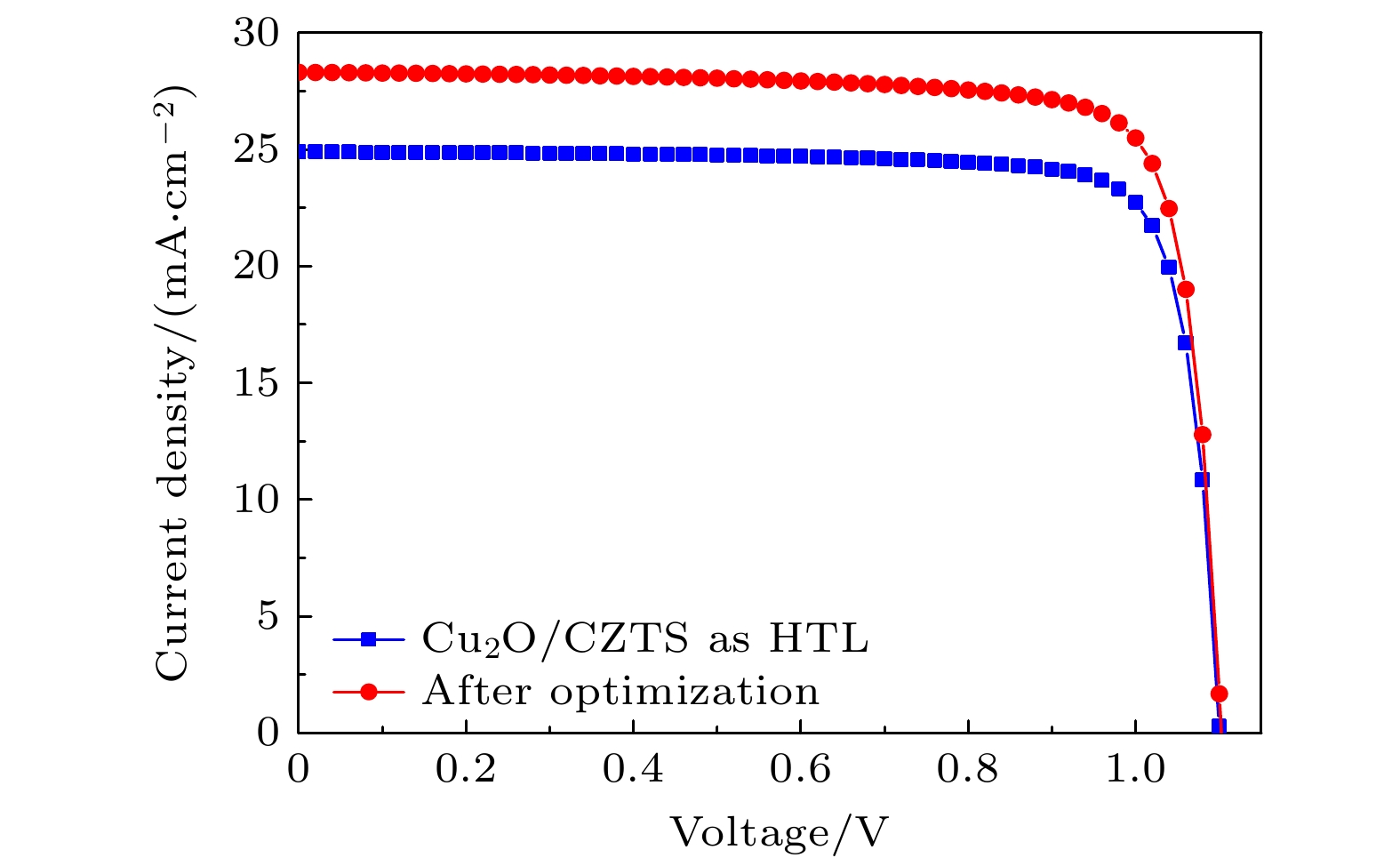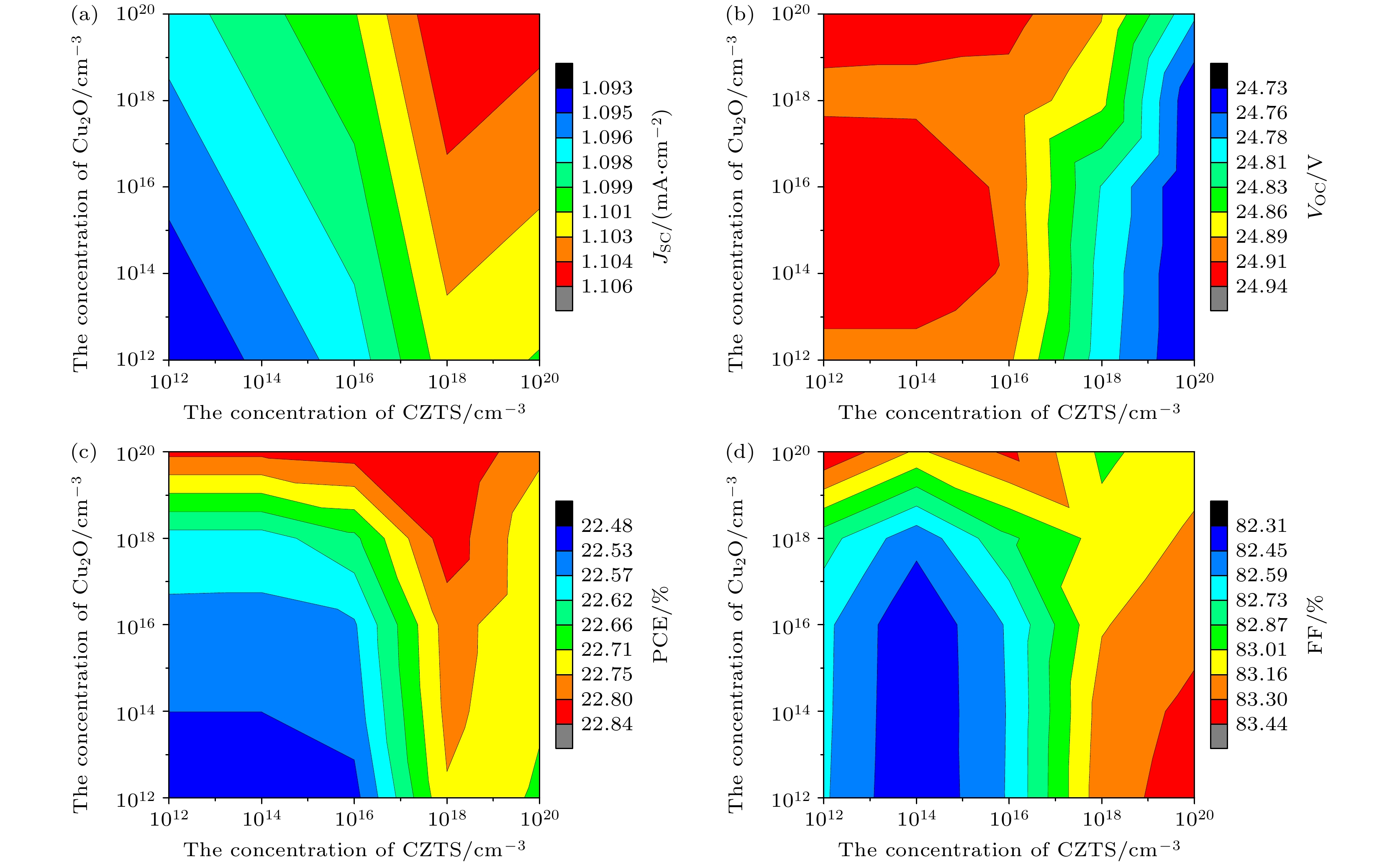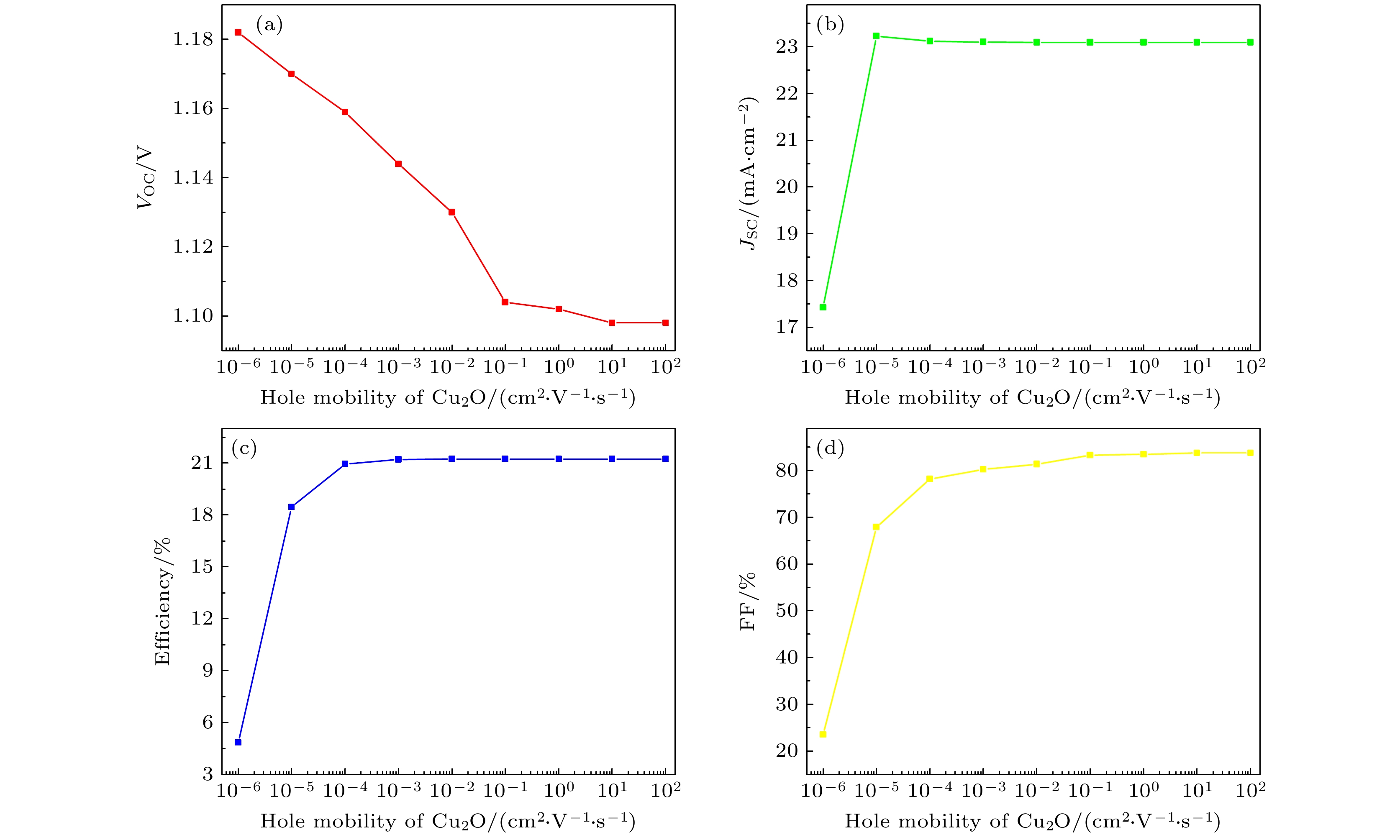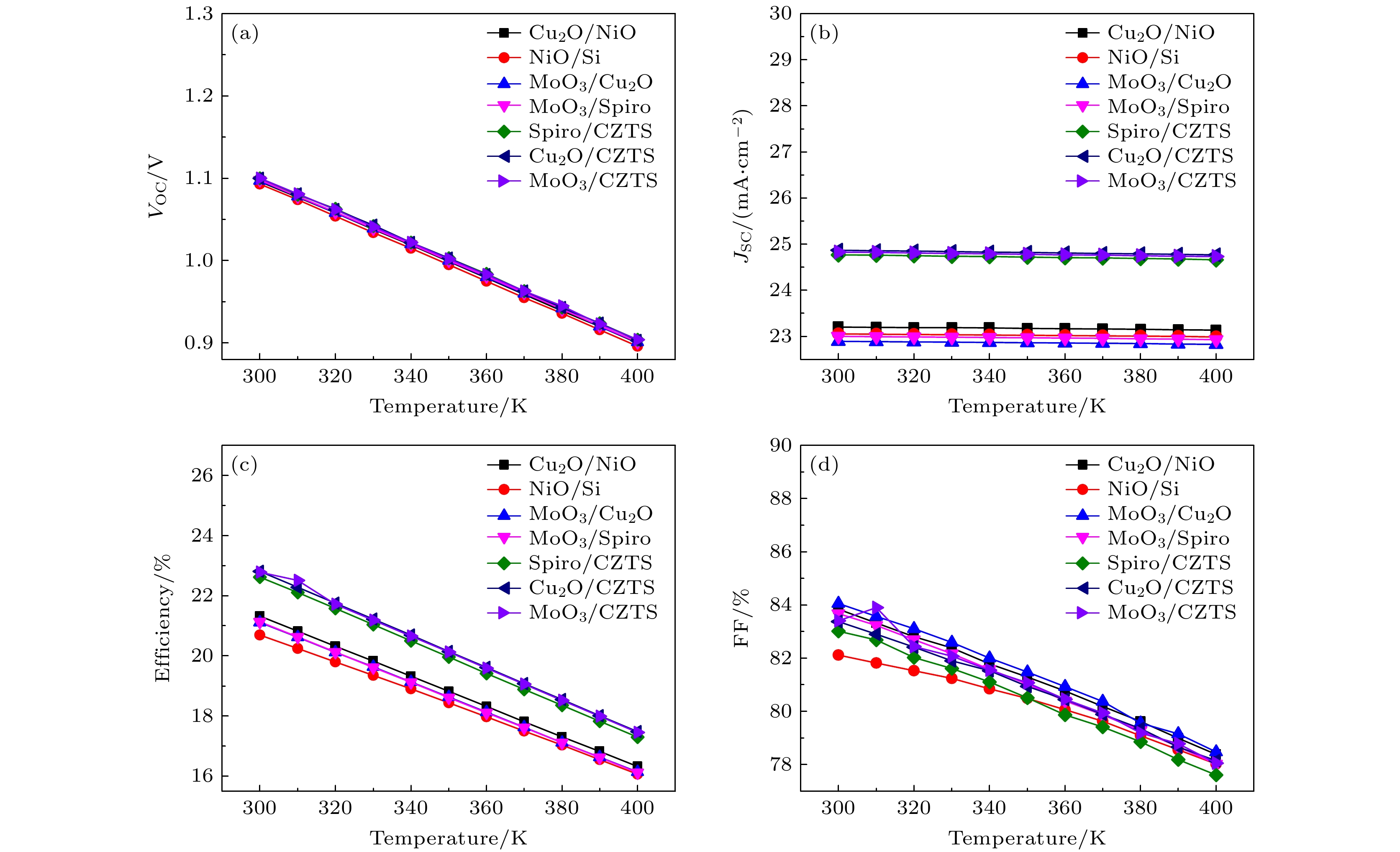-
双钙钛矿材料以其低成本、环境友好等优势在太阳能电池领域引起广泛关注. 本研究在已报道的ITO/ZnO/Cs2AgBiI6/HTL/Au单空穴传输层太阳能电池结构基础上, 提出了ITO/ZnO/Cs2AgBiI6/HTL1/HTL2/Au的双空穴传输层结构, 并使用Silvaco TCAD进一步分析了基于Cs2AgBiI6的双空穴传输层太阳能电池的内部物理机制. 结果表明, 与各单空穴传输层钙钛矿太阳能电池相比, 使用Cu2O/NiO和NiO/Si作为双空穴传输层的太阳能电池效率有所提高. 与Spiro-OMeTAD/CZTS双空穴传输层太阳能电池相比, 使用Cu2O/CZTS和MoO3/CZTS作为双空穴传输层的效率也有所提高. 其中, 性能最好的Cu2O/CZTS双空穴传输层太阳能电池效率为22.85%. 经过钙钛矿层和传输层的厚度优化后, 光电转换效率提升至25.62%. 此外, 模拟结果还揭示了温度和掺杂浓度对太阳能电池特性的影响. 这将有利于在无铅、无毒、环保的基础上, 为双钙钛矿太阳能电池的能效提高提供理论指导.Double perovskite materials have received significant attention in the photovoltaic field due to their low cost, environmental friendliness, and lead-free composition, which make them ideal candidates for next-generation solar cell applications. In this work, the photovoltaic performance of solar cells using Cs2AgBiI6 as the light-absorbing layer is systematically investigated through simulations using Silvaco ATLAS software. Based on the previously reported single hole transport layer device architecture, namely ITO/ZnO/Cs2AgBiI6/HTL/Au, a new dual hole transport layer structure ITO/ZnO/Cs2AgBiI6/HTL1/HTL2/Au is proposed. Different dual hole transport layer combinations are explored, and their influence on the internal physical mechanism and the device performance are analyzed and optimized in detail. The simulation results show that the devices using Cu2O/NiO and NiO/Si respectively as dual hole transport layer significantly improve charge extraction and generate a negative electric field at the interface, thereby reducing recombination losse and accelerating the transport of hole carriers. These two configurations exhibit substantially higher efficiencies than those configurations with a single hole transport layer, confirming the advantages of the dual hole transport layer structure. Additionally, devices using Cu2O/CZTS and MoO3/CZTS as dual hole transport layer show better performance than the reference structure using Spiro-OMeTAD/CZTS, indicating the potential for further improvement by optimizing material selection and layer properties. Of the various dual hole transport layer combinations tested, the structure utilizing Cu2O/CZTS achieves the highest simulated power conversion efficiency (PCE) of 22.85%. By optimizing the thickness of each functional layer, the efficiency can be further increased to 25.62%, and the optimal layer thickness is determined to be 40 nm for ZnO, 850 nm for Cs2AgBiI6, 140 nm for Cu2O, and 150 nm for CZTS. Furthermore, the effects of environmental and material parameters, such as temperature and hole transport layer doping concentration, on device performance are investigated. This study lays a theoretical foundation for the design and enhancement of double perovskite solar cells. By demonstrating the potential that the dual hole transport layer structures can significantly improve device efficiency, their value in advancing environmentally friendly and lead-free photovoltaic technologies becomes very prominent. The insights gained from this research pave the way for developing high-performance double perovskite solar cells with optimized architectures and material properties.
-
Keywords:
- double perovskite solar cell /
- dual hole transport layers /
- photoelectric conversion efficiency /
- optimization
[1] Hasan S A U, Zahid M A, Park S, Yi J 2024 Sol. RRL 8 2300967
 Google Scholar
Google Scholar
[2] Cheng M, Jiang J, Yan C, Lin Y, Mortazavi M, Kaul A B, Jiang Q 2024 Nanomaterials 14 391
 Google Scholar
Google Scholar
[3] Liu H R, Zhang Z H, Yang F, Yang J E, Grace A N, Li J M, Tripathi S, Jain S M 2021 Coatings 11 1045
 Google Scholar
Google Scholar
[4] Machin A, Marquez F 2024 Materials 17 1165
 Google Scholar
Google Scholar
[5] 万婷婷, 朱安康, 郭友敏, 汪春昌 2017 材料导报 31 16
 Google Scholar
Google Scholar
Wan T T, Zhu A K, Guo Y M, Wang C C 2017 Mater. Rev. 31 16
 Google Scholar
Google Scholar
[6] Zhai M, Chen C, Cheng M 2023 Sol. Energy 253 563
 Google Scholar
Google Scholar
[7] Meyer E, Mutukwa D, Zingwe N, Taziwa R 2018 Metals 8 667
 Google Scholar
Google Scholar
[8] Yuan Y, Yan G, Hong R, Liang Z, Kirchartz T 2022 Adv. Mater. 34 2108132
 Google Scholar
Google Scholar
[9] Zhao X G, Yang J H, Fu Y, Yang D, Xu Q, Yu L, Wei S H, Zhang L 2017 J. Am. Chem. Soc. 139 2630
 Google Scholar
Google Scholar
[10] Ji F, Boschloo G, Wang F, Gao F 2023 Sol. RRL 7 2201112
 Google Scholar
Google Scholar
[11] chrafih Y, Al Hattab M, Rahmani K 2023 J. Alloys Compd. 960 170650
 Google Scholar
Google Scholar
[12] Amraoui S, Feraoun A, Kerouad M 2022 Inorg. Chem. Commun. 140 109395
 Google Scholar
Google Scholar
[13] Slavney A H, Hu T, Lindenberg A M, Karunadasa H I 2016 J. Am. Chem. Soc. 138 2138
 Google Scholar
Google Scholar
[14] Huang Q, Liu J, Qi F, Pu Y, Zhang N, Yang J, Liang Z, Tian C 2023 J. Environ. Chem. Eng. 11 109960
 Google Scholar
Google Scholar
[15] Creutz S E, Crites E N, De Siena M C, Gamelin D R 2018 Nano Lett. 18 1118
 Google Scholar
Google Scholar
[16] Rehman M A, Ur Rehman J, Tahir M B 2023 J. Phys. Chem. Solids. 181 111443
 Google Scholar
Google Scholar
[17] Yadav S C, Srivastava A, Manjunath V, Kanwade A, Devan R S, Shirage P M 2022 Mater. Today Phys. 26 100731
 Google Scholar
Google Scholar
[18] Volonakis G, Filip M R, Haghighirad A A, Sakai N, Wenger B, Snaith H J, Giustino F 2016 J. Phys. Chem. Lett. 7 1254
 Google Scholar
Google Scholar
[19] Igbari F, Wang R, Wang Z K, Ma X J, Wang Q, Wang K L, Zhang Y, Liao L S, Yang Y 2019 Nano Lett. 19 2066
 Google Scholar
Google Scholar
[20] Hossain M K, Samajdar D P, Das R C, Arnab A A, Rahman M F, Rubel M H K, Islam M R, Bencherif H, Pandey R, Madan J, Mohammed M K A 2023 Energy Fuels 37 3957
 Google Scholar
Google Scholar
[21] Alla M, Manjunath V, Choudhary E, Samtham M, Sharma S, Shaikh P A, Rouchdi M, Fares B 2023 Phys. Status Solidi A 220 2200642
 Google Scholar
Google Scholar
[22] Zarabinia N, Rasuli R 2021 Energy Sources Part A 43 2443
 Google Scholar
Google Scholar
[23] Chen Q M, Ni Y, Dou X M, Yoshinori Y 2022 Crystals 12 68
 Google Scholar
Google Scholar
[24] Azadinia M, Ameri M, Ghahrizjani R T, Fathollahi M 2021 Mater. Today Energy 20 100647
 Google Scholar
Google Scholar
[25] Yoon S, Kim H, Shin E Y, Bae I G, Park B, Noh Y Y, Hwang I 2016 Org. Electron. 32 200
 Google Scholar
Google Scholar
[26] Chen G S, Chen Y C, Lee C T, Lee H Y 2018 Sol. Energy 174 897
 Google Scholar
Google Scholar
[27] Dahal B, Rezaee M D, Gotame R C, Li W 2023 Mater. Today Commun. 36 106846
 Google Scholar
Google Scholar
[28] Kim D I, Lee J W, Jeong R H, Nam S H, Hwang K H, Boo J H 2019 Surf. Coat. Technol. 357 189
 Google Scholar
Google Scholar
[29] Chen Y, Zhang M, Li F Q, Yang Z Y 2023 Coatings 13 644
 Google Scholar
Google Scholar
[30] Islam T, Jani R, Amin S M A, Shorowordi K M, Nishat S S, Kabir A, Taufique M F N, Chowdhury S, Banerjee S, Ahmed S 2020 Comput. Mater. Sci. 184 109865
 Google Scholar
Google Scholar
[31] Anoop K M, Ahipa T N 2023 Sol. Energy 263 111937
 Google Scholar
Google Scholar
[32] Kumar A 2021 Superlattices Microstructure. 153 106872
 Google Scholar
Google Scholar
[33] Hossain M K, Arnab A A, Das R C, Hossain K M, Rubel M H K, Rahman M F, Bencherif H, Emetere M E, Mohammed M K A, Pandey R 2022 RSC Adv. 12 34850
 Google Scholar
Google Scholar
[34] Bhattarai S, Hossain M K, Pandey R, Madan J, Samajdar D P, Rahman M F, Ansari M Z, Amami M 2023 Energy Fuels 37 10631
 Google Scholar
Google Scholar
-
图 8 Cs2AgBiI6太阳能电池中(a) Spiro/CZTS, (b) MoO3/CZTS, (c) Cu2O/CZTS双空穴传输层界面上的电场, 以及(d) Spiro/CZTS, (e) MoO3/CZTS, (f) Cu2O/CZTS双空穴传输层的复合率
Fig. 8. Electric fields at the interfaces of Cs2AgBiI6 PSCs with different HTL combinations: (a) Spiro/CZTS; (b) MoO3/CZTS; (c) Cu2O/CZTS. Charge recombination dynamics of Cs2AgBiI6 PSCs with different HTL combinations: (d) Spiro/CZTS; (e) MoO3/ CZTS; (f) Cu2O/CZTS.
图 10 (a)电子传输层ZnO、(b)钙钛矿层Cs2AgBiI6、双空穴传输层(c) CZTS和(d) Cu2O厚度对钙钛矿太阳能电池VOC, JSC, FF和PCE的影响
Fig. 10. Effects of thicknesses of (a) electron transport layer ZnO, (b) perovskite layer Cs2AgBiI6, (c) hole transport layer Ⅰ CZTS, (d) hole transport layer Ⅱ Cu2O on VOC, JSC, FF and PCE of dual HTLs perovskite solar cell.
表 1 太阳能电池不同层材料的参数
Table 1. Device parameters for different layers of the cells.
Parameter ZnO Cs2AgBiI6 Cu2O MoO3 CZTS Spiro-OMeTAD NiO P3HT Si Thickness/nm 50 800 50 50 100 200 100 50 50 Permittivity εr 9 6.5 7.5 12.5 9 3 10.7 3 11.9 Band gap/eV 3.3 1.6 2.17 3 1.4 2.2 3.8 1.7 1.12 Affinity/eV 4 3.9 3.2 2.5 3.8 3 1.46 3.5 4.17 NC/(1018 cm–3) 3.7 10.0 2.0 2.2 2.2 2.2 28.0 2000.0 250.0 NV/(1018 cm–3) 18.0 10.0 11.0 18.0 1.8 250.0 10.0 2000.0 180.0 ND(1018 cm–3) 1 0 0 0 0 0 0 0 0 NA/(1015 cm–3) 0 1 1000 1000 10000 1000 1000 1000 10 μn/(cm2·V–1·s–1) 100 2 200 25 100 2×10–4 12 1.8×10–3 1500 μp/(cm2·V–1·s–1) 25 2 80 100 12.5 2×10–4 2.8 1.86×10–2 480 表 2 不同单空穴传输层电池的输出参数
Table 2. Performance parameters of PSCs with various HTLs.
电池结构 VOC/V JSC/(mA·cm–2) PCE/% FF/% FTO/ZnO/Cs2AgBiI6/Cu2O/Au 1.096 23.02 21.17 83.91 FTO/ZnO/Cs2AgBiI6/MoO3/Au 1.097 23.01 21.16 83.83 FTO/ZnO/Cs2AgBiI6/CZTS/Au 1.088 22.07 20.00 83.29 FTO/ZnO/Cs2AgBiI6/Spiro/Au 1.095 23.08 20.14 79.69 FTO/ZnO/Cs2AgBiI6/NiO/Au 1.095 23.00 20.64 82.10 FTO/ZnO/Cs2AgBiI6/P3HT/Au 1.070 23.04 17.91 72.65 FTO/ZnO/Cs2AgBiI6/Si/Au 1.055 22.00 17.18 74.02 ITO/ZnO/Cs2AgBiI6/Spiro/Au[34] 1.08 24.20 21.72 83.14 ITO/ZnO/Cs2AgBiI6/Spiro/Au[33] 1.08 23.74 20.31 79.28 表 3 不同双空穴传输层电池的输出参数
Table 3. Performance parameters of PSCs with dual HTLs.
Device structures VOC/V JSC/(mA·cm–2) PCE/% FF/% FTO/ZnO/Cs2AgBiI6/Cu2O/NiO/Au 1.098 23.19 21.39 83.46 FTO/ZnO/Cs2AgBiI6/NiO/Si/Au 1.093 23.05 20.71 82.21 FTO/ZnO/Cs2AgBiI6/MoO3/Cu2O/Au 1.097 22.9 21.13 83.44 FTO/ZnO/Cs2AgBiI6/MoO3/Spiro/Au 1.097 23.96 21.12 83.77 表 4 不同HTL/CZTS双空穴传输层电池的输出参数
Table 4. Performance parameters of PSCs with HTL/CZTS.
Device structures VOC/V JSC/(mA·cm–2) PCE/% FF/% FTO/ZnO/Cs2AgBiI6/Spiro/CZTS/Au 1.1 24.73 22.62 83.15 FTO/ZnO/Cs2AgBiI6/Cu2O/CZTS/Au 1.1 24.89 22.85 83.46 FTO/ZnO/Cs2AgBiI6/MoO3/CZTS/Au 1.1 24.83 22.79 83.44 表 5 正交实验中Cu2O和CZTS作为HTL的太阳能电池性能参数
Table 5. Performance parameters of PSCs with Cu2O and CZTS as HTL in orthogonal experiments.
Experiment No. Thickness/nm VOC/V JSC/(mA·cm–2) PCE/% FF/% ZnO Cs2AgBiI6 CZTS Cu2O 1 40 850 150 140 1.103 28.31 25.62 82.05 2 40 900 170 150 1.100 28.36 25.46 81.61 3 40 950 160 160 1.098 28.37 25.25 81.06 4 50 850 170 160 1.102 27.92 25.26 82.10 5 50 900 160 140 1.101 28.10 25.21 81.49 6 50 950 150 150 1.098 28.09 25.01 81.09 7 60 850 160 150 1.103 27.80 25.15 82.02 8 60 900 150 160 1.100 27.56 24.75 81.64 9 60 950 170 140 1.098 28.30 25.15 80.94 -
[1] Hasan S A U, Zahid M A, Park S, Yi J 2024 Sol. RRL 8 2300967
 Google Scholar
Google Scholar
[2] Cheng M, Jiang J, Yan C, Lin Y, Mortazavi M, Kaul A B, Jiang Q 2024 Nanomaterials 14 391
 Google Scholar
Google Scholar
[3] Liu H R, Zhang Z H, Yang F, Yang J E, Grace A N, Li J M, Tripathi S, Jain S M 2021 Coatings 11 1045
 Google Scholar
Google Scholar
[4] Machin A, Marquez F 2024 Materials 17 1165
 Google Scholar
Google Scholar
[5] 万婷婷, 朱安康, 郭友敏, 汪春昌 2017 材料导报 31 16
 Google Scholar
Google Scholar
Wan T T, Zhu A K, Guo Y M, Wang C C 2017 Mater. Rev. 31 16
 Google Scholar
Google Scholar
[6] Zhai M, Chen C, Cheng M 2023 Sol. Energy 253 563
 Google Scholar
Google Scholar
[7] Meyer E, Mutukwa D, Zingwe N, Taziwa R 2018 Metals 8 667
 Google Scholar
Google Scholar
[8] Yuan Y, Yan G, Hong R, Liang Z, Kirchartz T 2022 Adv. Mater. 34 2108132
 Google Scholar
Google Scholar
[9] Zhao X G, Yang J H, Fu Y, Yang D, Xu Q, Yu L, Wei S H, Zhang L 2017 J. Am. Chem. Soc. 139 2630
 Google Scholar
Google Scholar
[10] Ji F, Boschloo G, Wang F, Gao F 2023 Sol. RRL 7 2201112
 Google Scholar
Google Scholar
[11] chrafih Y, Al Hattab M, Rahmani K 2023 J. Alloys Compd. 960 170650
 Google Scholar
Google Scholar
[12] Amraoui S, Feraoun A, Kerouad M 2022 Inorg. Chem. Commun. 140 109395
 Google Scholar
Google Scholar
[13] Slavney A H, Hu T, Lindenberg A M, Karunadasa H I 2016 J. Am. Chem. Soc. 138 2138
 Google Scholar
Google Scholar
[14] Huang Q, Liu J, Qi F, Pu Y, Zhang N, Yang J, Liang Z, Tian C 2023 J. Environ. Chem. Eng. 11 109960
 Google Scholar
Google Scholar
[15] Creutz S E, Crites E N, De Siena M C, Gamelin D R 2018 Nano Lett. 18 1118
 Google Scholar
Google Scholar
[16] Rehman M A, Ur Rehman J, Tahir M B 2023 J. Phys. Chem. Solids. 181 111443
 Google Scholar
Google Scholar
[17] Yadav S C, Srivastava A, Manjunath V, Kanwade A, Devan R S, Shirage P M 2022 Mater. Today Phys. 26 100731
 Google Scholar
Google Scholar
[18] Volonakis G, Filip M R, Haghighirad A A, Sakai N, Wenger B, Snaith H J, Giustino F 2016 J. Phys. Chem. Lett. 7 1254
 Google Scholar
Google Scholar
[19] Igbari F, Wang R, Wang Z K, Ma X J, Wang Q, Wang K L, Zhang Y, Liao L S, Yang Y 2019 Nano Lett. 19 2066
 Google Scholar
Google Scholar
[20] Hossain M K, Samajdar D P, Das R C, Arnab A A, Rahman M F, Rubel M H K, Islam M R, Bencherif H, Pandey R, Madan J, Mohammed M K A 2023 Energy Fuels 37 3957
 Google Scholar
Google Scholar
[21] Alla M, Manjunath V, Choudhary E, Samtham M, Sharma S, Shaikh P A, Rouchdi M, Fares B 2023 Phys. Status Solidi A 220 2200642
 Google Scholar
Google Scholar
[22] Zarabinia N, Rasuli R 2021 Energy Sources Part A 43 2443
 Google Scholar
Google Scholar
[23] Chen Q M, Ni Y, Dou X M, Yoshinori Y 2022 Crystals 12 68
 Google Scholar
Google Scholar
[24] Azadinia M, Ameri M, Ghahrizjani R T, Fathollahi M 2021 Mater. Today Energy 20 100647
 Google Scholar
Google Scholar
[25] Yoon S, Kim H, Shin E Y, Bae I G, Park B, Noh Y Y, Hwang I 2016 Org. Electron. 32 200
 Google Scholar
Google Scholar
[26] Chen G S, Chen Y C, Lee C T, Lee H Y 2018 Sol. Energy 174 897
 Google Scholar
Google Scholar
[27] Dahal B, Rezaee M D, Gotame R C, Li W 2023 Mater. Today Commun. 36 106846
 Google Scholar
Google Scholar
[28] Kim D I, Lee J W, Jeong R H, Nam S H, Hwang K H, Boo J H 2019 Surf. Coat. Technol. 357 189
 Google Scholar
Google Scholar
[29] Chen Y, Zhang M, Li F Q, Yang Z Y 2023 Coatings 13 644
 Google Scholar
Google Scholar
[30] Islam T, Jani R, Amin S M A, Shorowordi K M, Nishat S S, Kabir A, Taufique M F N, Chowdhury S, Banerjee S, Ahmed S 2020 Comput. Mater. Sci. 184 109865
 Google Scholar
Google Scholar
[31] Anoop K M, Ahipa T N 2023 Sol. Energy 263 111937
 Google Scholar
Google Scholar
[32] Kumar A 2021 Superlattices Microstructure. 153 106872
 Google Scholar
Google Scholar
[33] Hossain M K, Arnab A A, Das R C, Hossain K M, Rubel M H K, Rahman M F, Bencherif H, Emetere M E, Mohammed M K A, Pandey R 2022 RSC Adv. 12 34850
 Google Scholar
Google Scholar
[34] Bhattarai S, Hossain M K, Pandey R, Madan J, Samajdar D P, Rahman M F, Ansari M Z, Amami M 2023 Energy Fuels 37 10631
 Google Scholar
Google Scholar
计量
- 文章访问数: 3293
- PDF下载量: 84
- 被引次数: 0













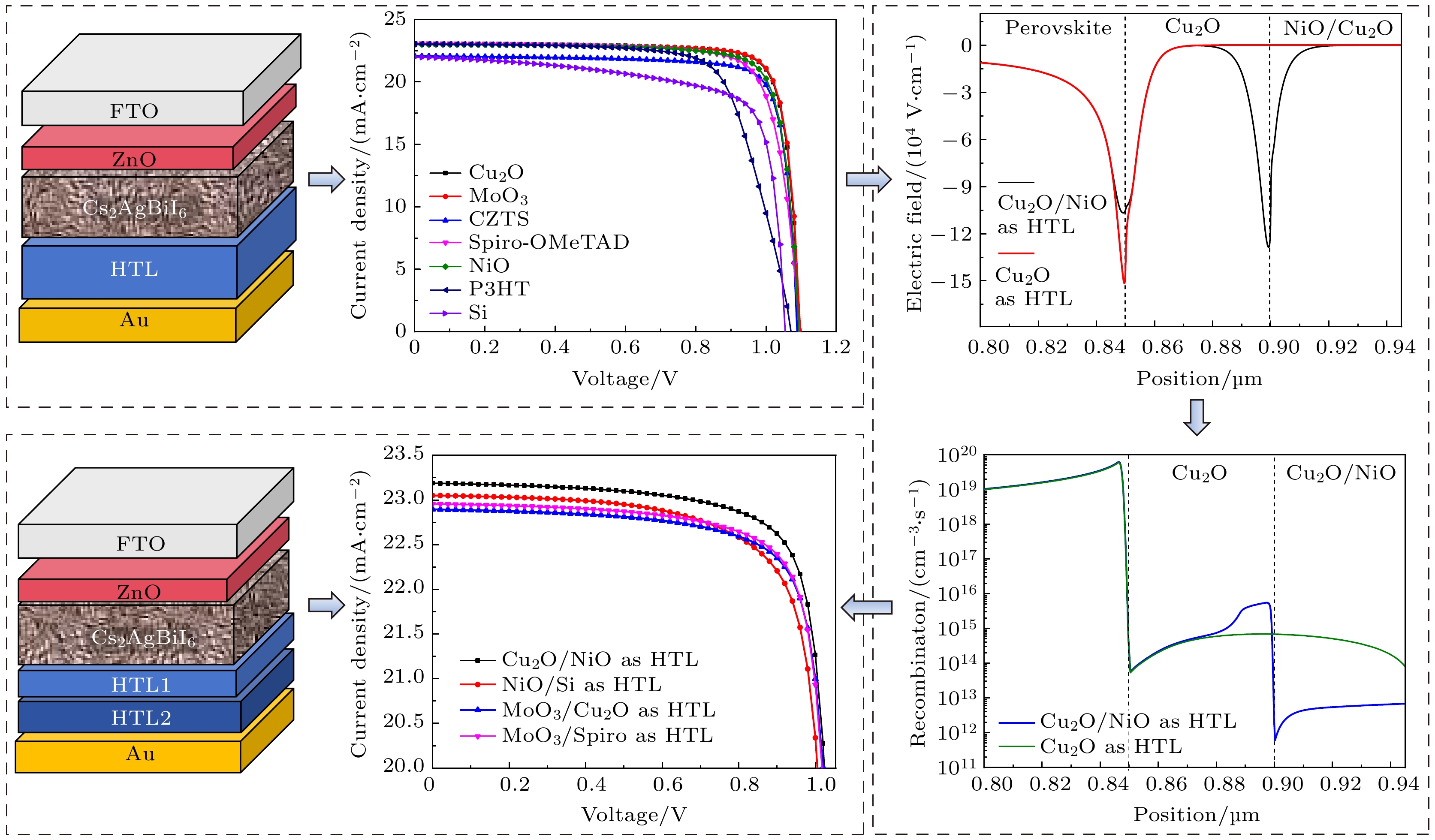
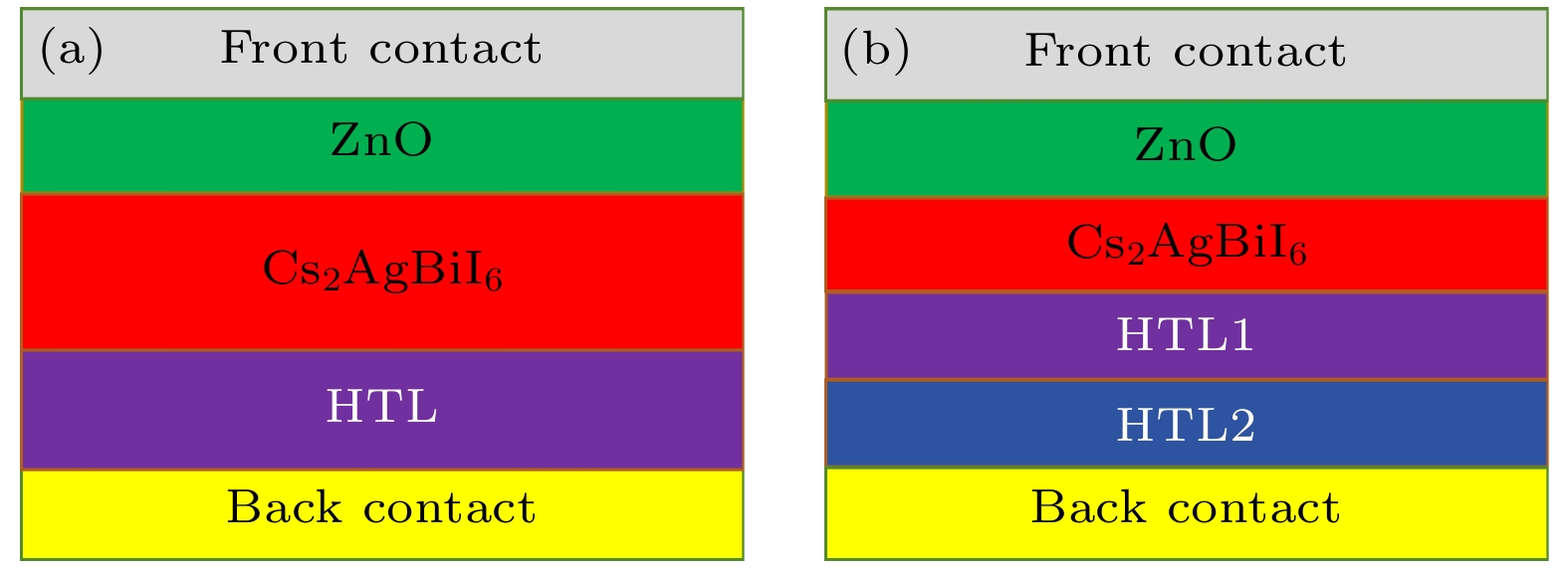
 下载:
下载:
